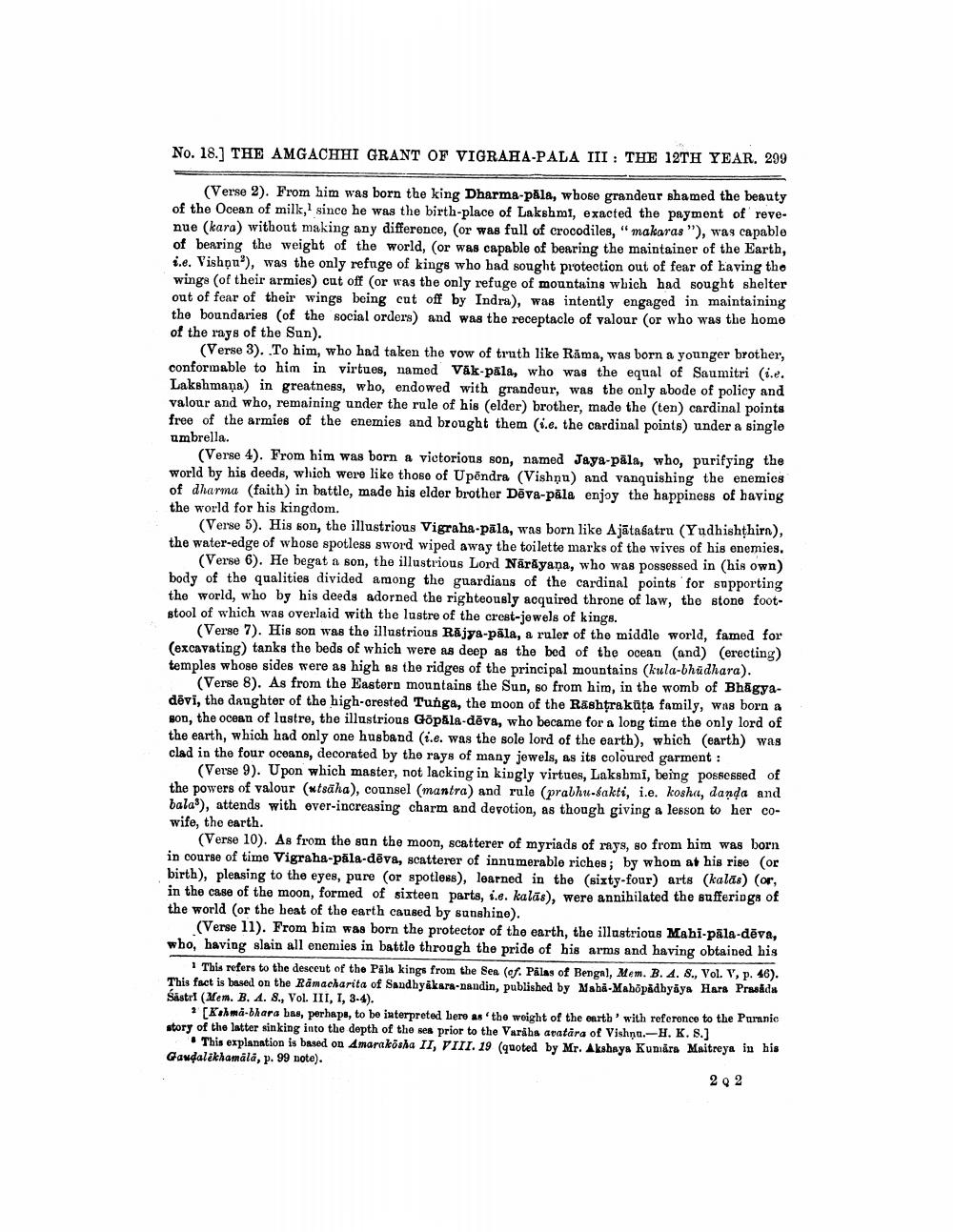________________
No. 18.] THE AMGACHHI GRANT OF VIGRAHA-PALA III : THE 12TH YEAR. 299
(Verse 2). From him was born the king Dharma-pāla, whose grandeur shamed the beauty of the Ocean of milk, since he was the birth-place of Lakshmi, exacted the payment of revenue (kara) without making any difference, (or was full of crocodiles, "makaras "), was capable of bearing the weight of the world, (or was capable of bearing the maintainer of the Earth, i.e. Vishọu'), was the only refuge of kings who had sought protection out of fear of Laving the wings (of their armies) cut off (or was the only refuge of mountains wbich had sought shelter out of fear of their wings being cut off by Indra), was intently engaged in maintaining the boundaries (of the social orders) and was the receptacle of valour (or who was the home of the rays of the Sun).
(Verse 3). To him, who had taken the vow of truth like Rāma, was born a younger brother, conformable to him in virtues, named Vák-pala, who was the equal of Saumitri (i.e. Lakshmana) in greatness, who, endowed with grandeur, was the only abode of policy and valour and who, remaining under the rule of his (elder) brother, made the (ten) cardinal points free of the armies of the enemies and brought them (i.e. the cardinal points) under a single umbrella.
(Verse 4). From him was born a victorious son, named Jaya-pala, who, purifying the world by his deeds, which were like those of Upēndra (Vishnu) and vanquishing the enemies of dharma (faith) in battle, made his elder brother Dēva-pāla enjoy the happiness of having the world for his kingdom.
(Verse 5). His son, the illustrious Vigraha-pāla, was born like Ajātasatru (Yudhishthirn), the water-edge of whose spotless sword wiped away the toilette marks of the wives of his enemies.
(Verse 6). He begat a son, the illustrious Lord Nārāyana, who was possessed in his own) body of the qualities divided among the guardians of the cardinal points for supporting the world, who by his deeds adorned the righteously acquired throne of law, the stone footstool of which was overlaid with the lustre of the creat-jowels of kings.
(Verse 7). His son was the illustrious Rajya-pāla, a ruler of the middle world, famed for (excavating) tanks the beds of which were as deep as the bed of the ocean (and) erecting) temples whose sides were as high as the ridges of the principal mountains (kula-bhūdhara).
(Verse 8). As from the Eastern mountains the Sun, so from him, in the womb of Bhāgyadēvi, the daughter of the high-crested Tunga, the moon of the Rashtra kūţa family, was born a son, the ocean of lustre, the illustrious Göpåla-dēva, who became for a long time the only lord of the earth, which had only one husband (i.e. was the sole lord of the earth), which earth) was clad in the four oceans, decorated by the rays of many jewels, as its coloured garment :
(Verse 9). Upon which master, not lacking in kingly virtues, Lakshmi, being possessed of the powers of valour (utsäha), counsel (mantra) and rule (prabhu-sakti, i.e. kosha, danda and bala), attends with over-increasing charm and devotion, as though giving a lesson to her cowife, the earth.
(Verse 10). As from the son the moon, scatterer of myriads of rays, so from him was born in course of time Vigraha-pala-dēva, scatterer of innumerable riches; by whom at his rise (or birth), pleasing to the eyes, pure (or spotless), learned in the sixty-four) arts (kalās) (or, in the case of the moon, formed of sixteen parts, i.e. kalās), were annihilated the sufferings of the world (or the beat of the earth caused by sunshino).
(Verse 11). From him was born the protector of the earth, the illustrious Mahi-pāla dēva, who, having slain all enemies in battle through the pride of his arms and having obtained his
This refers to the descout of the Palu kings from the Sea (f. Pilas of Bengal, Mem. B. 4. 8., Vol. V, p. 46). This fact is based on the Ramacharita of Sandhyakara-nandin, published by Maba-Mabopadhyaya Hara Prasada Sastri (Mem. B. 4. 8., Vol. III, 1, 3-4).
? (Kshma-bhara bas, perhaps, to be interpreted here as the weight of the earth' with reference to the Paranic story of the latter sinking into the depth of the ses prior to the Varaha avatāra of Vishnu.-H. K. S.]
This explanation is based on Amarakosha II, VIII. 19 (quoted by Mr. Akshaya Kumara Maitreya in his Gandalikhamala, p. 99 note).
292




